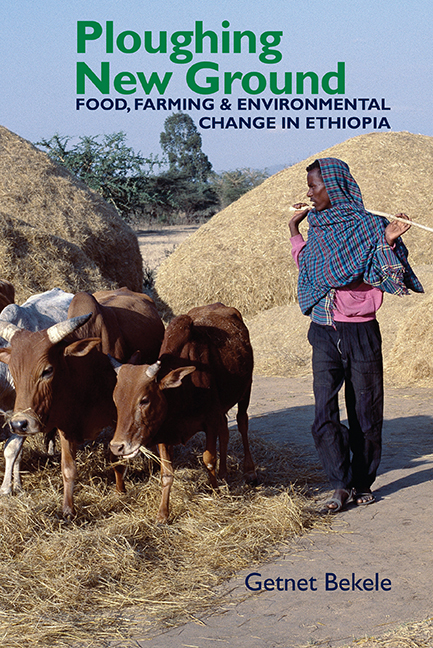Book contents
- Frontmatter
- Dedication
- Contents
- List of Maps and Tables
- Acknowledgements
- Note on Orthography
- Acronyms & Abbreviations
- Glossary
- Map
- Introduction
- 1 Landscape Pastoral: The making and remaking of a grassland environment, 1886–1916
- 2 Negotiating a Landscape: Continuity and change in a grassland environment, 1917–1941
- 3 Blurring the Boundaries: The ascendancy of crop production in a flexible environment, 1942–1955
- 4 Fresh Encounters and Morphing Strategies: The changing organization of production in an era of agricultural intervention, 1956–1965
- 5 Inputs, Outputs and the Farm: Transformations in the science, politics and praxis of agricultural development, 1966–1974
- 6 Competition and Co–existence: Creating space for small- to large-scale farming, 1966-1974
- 7 Of Production and Production Relations: Farming in an era of revolutionary change and socialist development, 1975–1991
- 8 Vicious Circle: Agricultural development at the time of ‘revolutionary democracy’, 1991–2016
- Conclusion
- Bibliography
- Index
- Eastern African Studies
5 - Inputs, Outputs and the Farm: Transformations in the science, politics and praxis of agricultural development, 1966–1974
Published online by Cambridge University Press: 31 August 2018
- Frontmatter
- Dedication
- Contents
- List of Maps and Tables
- Acknowledgements
- Note on Orthography
- Acronyms & Abbreviations
- Glossary
- Map
- Introduction
- 1 Landscape Pastoral: The making and remaking of a grassland environment, 1886–1916
- 2 Negotiating a Landscape: Continuity and change in a grassland environment, 1917–1941
- 3 Blurring the Boundaries: The ascendancy of crop production in a flexible environment, 1942–1955
- 4 Fresh Encounters and Morphing Strategies: The changing organization of production in an era of agricultural intervention, 1956–1965
- 5 Inputs, Outputs and the Farm: Transformations in the science, politics and praxis of agricultural development, 1966–1974
- 6 Competition and Co–existence: Creating space for small- to large-scale farming, 1966-1974
- 7 Of Production and Production Relations: Farming in an era of revolutionary change and socialist development, 1975–1991
- 8 Vicious Circle: Agricultural development at the time of ‘revolutionary democracy’, 1991–2016
- Conclusion
- Bibliography
- Index
- Eastern African Studies
Summary
A relatively new development in the history of the lake region's agriculture between 1966 and 1974 pertained to the growing availability and adoption by the local farmers of modern inputs, chemical fertilizers and improved seed varieties, on a hitherto unprecedented scale. The technologies’ major promoters had been the state-organized and internationally financed ‘fertilizer trial’ and the fully-fledged ‘regional’ development programmes that became operational in that region and other parts of the country in that period. The Green Revolution technologies that these intervention programmes provided were not only different but they also became increasingly popular among a growing number of the local farmers. However, in Addis Ababa, agricultural development became an increasingly controversial and polarizing subject almost overnight. In fact, to Haile Selassie's critics, such technology-focused intervention programmes were misplaced, if not also damaging to the farmers’ short- and long-term interests. This chapter seeks to understand the degree to which the percolation and bifurcation of the politics and practice of agricultural development impacted ecological change and transformation in the region during this period.
POINTS OF CONVERGENCE
In terms of agricultural development, the mid- to late-1960s were, in Ethiopia as in most other parts of Africa and the rest of the developing world, times of high expectations and great enthusiasm. Feeding that enthusiasm at the global scale were two factors that had their origins in the previous half decade. These were the coming to an end of European colonial rule in most parts of Africa and the advancement that was made in major international research institutions in terms of engineered, improved seed varieties of some of the major staples, such as wheat and corn/maize, and new fertilizer packages of equal significance. The implication that these two factors had in the future of the science, politics and practice of agricultural development in Africa was Janus-faced. On the one hand, these technological breakthroughs tended to affirm the accuracy of the popular view that posited agricultural development as an intrinsically bio-scientific and production-centred endeavour. On the other hand, the political changes that had started to take place in Africa after the end of colonial rule tended to revamp and strengthen, rather than undermine, state power in agricultural development.
- Type
- Chapter
- Information
- Ploughing New GroundFood, Farming & Environmental Change in Ethiopia, pp. 104 - 123Publisher: Boydell & BrewerPrint publication year: 2017

